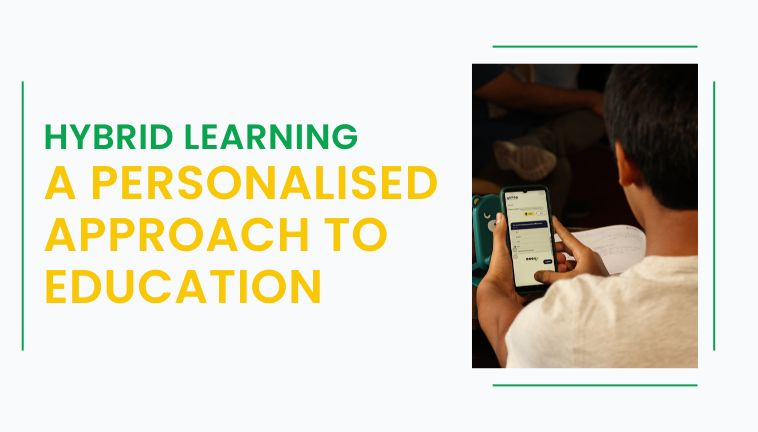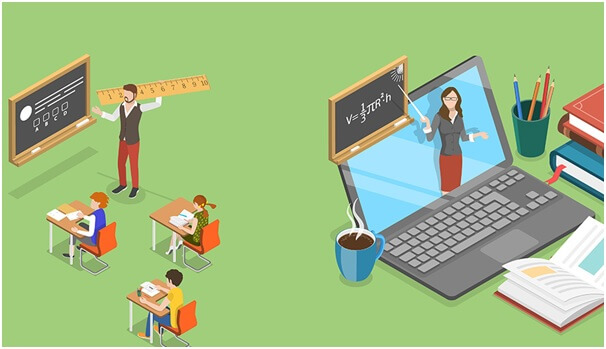Blogs
Hybrid Learning: A Personalized Approach to Education

In today’s rapidly evolving educational landscape, hybrid classrooms and hybrid learning have emerged as transformative models, blending traditional face-to-face teaching with digital engagement. As more schools and educational institutions actively seek ways to make learning more accessible, effective, and resilient, hybrid learning has emerged not only as a timely response to recent global disruptions but also as a sustainable model for the future. Moreover, this hybrid approach seamlessly bridges in-person and online learning, maximizing resources, tailoring learning experiences, and equipping students with essential digital literacy skills for a technology-driven world.

The Rise of Hybrid Classrooms
A hybrid classroom combines both physical and digital elements to create a flexible learning or hybrid learning environment. Students alternate between attending classes on campus and engaging remotely via digital platforms. They have access to real-time or recorded lectures, interactive discussions, and digital tools that support collaboration.
Research shows that demand for hybrid classrooms is on the rise. A study by EDUCAUSE found that 73% of students prefer classes that blend in-person and online components, highlighting flexibility as a key benefit. Additionally, the global e-learning market, valued at $315 billion in 2021, is projected to grow to $645 billion by 2030. This growth is largely fueled by rising demand for hybrid learning solutions, according to Grand View Research. These statistics highlight a clear trend: both educators and students are seeing the benefits of this blended model.
The Benefits of Hybrid Classrooms and Hybrid Learning
- Flexibility and Accessibility: Hybrid classrooms break down traditional barriers to learning. Students from remote areas or with personal constraints can participate equally, democratizing education. With internet access and a device, students can attend classes from virtually anywhere, making education more inclusive.
- Enhanced Student Engagement: Hybrid learning often incorporates interactive tools like quizzes, polls, and collaborative platforms, which keep students engaged. Research from Harvard shows that students engaged in hybrid learning have a 30% higher participation rate than in traditional classrooms.
- Teacher Efficiency and Resource Optimization: Hybrid classrooms reduce teachers' administrative workloads by integrating digital resources that can be reused and repurposed. Recorded lectures, digital assignments, and virtual office hours give teachers greater flexibility and more time to focus on student support.
- Future-Ready Skills: In hybrid learning environments, students learn more than just academic content; they acquire essential digital skills. With technology now integral to nearly every career, these skills prepare students for future work environments, giving them an edge in the job market.
Challenges and Solutions in Implementing Hybrid Classrooms
Despite the advantages, hybrid classrooms do face challenges, especially in regions where digital infrastructure is lacking. According to UNICEF, two-thirds of school-age children globally lack internet access at home. Bridging this digital divide is critical if hybrid learning is to become a truly universal model.
Schools can collaborate with governments and private organizations to implement supportive solutions. These may include providing affordable internet access, distributing devices to underprivileged students, and offering digital literacy programs. For instance, Schoolnet India has initiated projects to bring digital education to underserved areas. These projects equip students with both the necessary technology and skills to succeed in hybrid learning environments.
The Future is Hybrid Learning
As technology continues to advance, hybrid learning is poised to become the norm in education. Consequently, by embracing this innovative approach, we can create more engaging and effective learning experiences. This will lead to more equitable opportunities for students of all ages.
As a pioneer in educational technology, Schoolnet India is at the forefront of bringing hybrid classrooms and hybrid learning to schools across India. Through tools like KYAN and digital learning solutions, Schoolnet India empowers schools to adopt hybrid models that are scalable and effective, even in resource-constrained settings. By offering teacher training, digital content, and infrastructure support, Schoolnet India is helping create a future where hybrid learning is accessible to all.
Let's embrace the future of education and unlock the full potential of hybrid learning.





